Reflection Paper: Design Thinking Process Analysis
VerifiedAdded on 2022/11/14
|11
|3446
|335
Report
AI Summary
This reflection paper provides a comprehensive overview of a student's learning journey in a Design Thinking course. The paper explores various facets of design thinking, including the design process, teamwork dynamics, project management, and conceptualization. It delves into the application of design thinking principles, such as ideation and prototyping, and reflects on the importance of teamwork and collaboration in project development. The student analyzes their skill strengths and weaknesses, discusses the challenges encountered during the project, and proposes an action plan for future professional development. The paper also references weekly blog entries, demonstrating engagement with the course material and a deep understanding of the design thinking methodology. Overall, the reflection offers valuable insights into the practical application of design thinking and its impact on problem-solving and innovation.
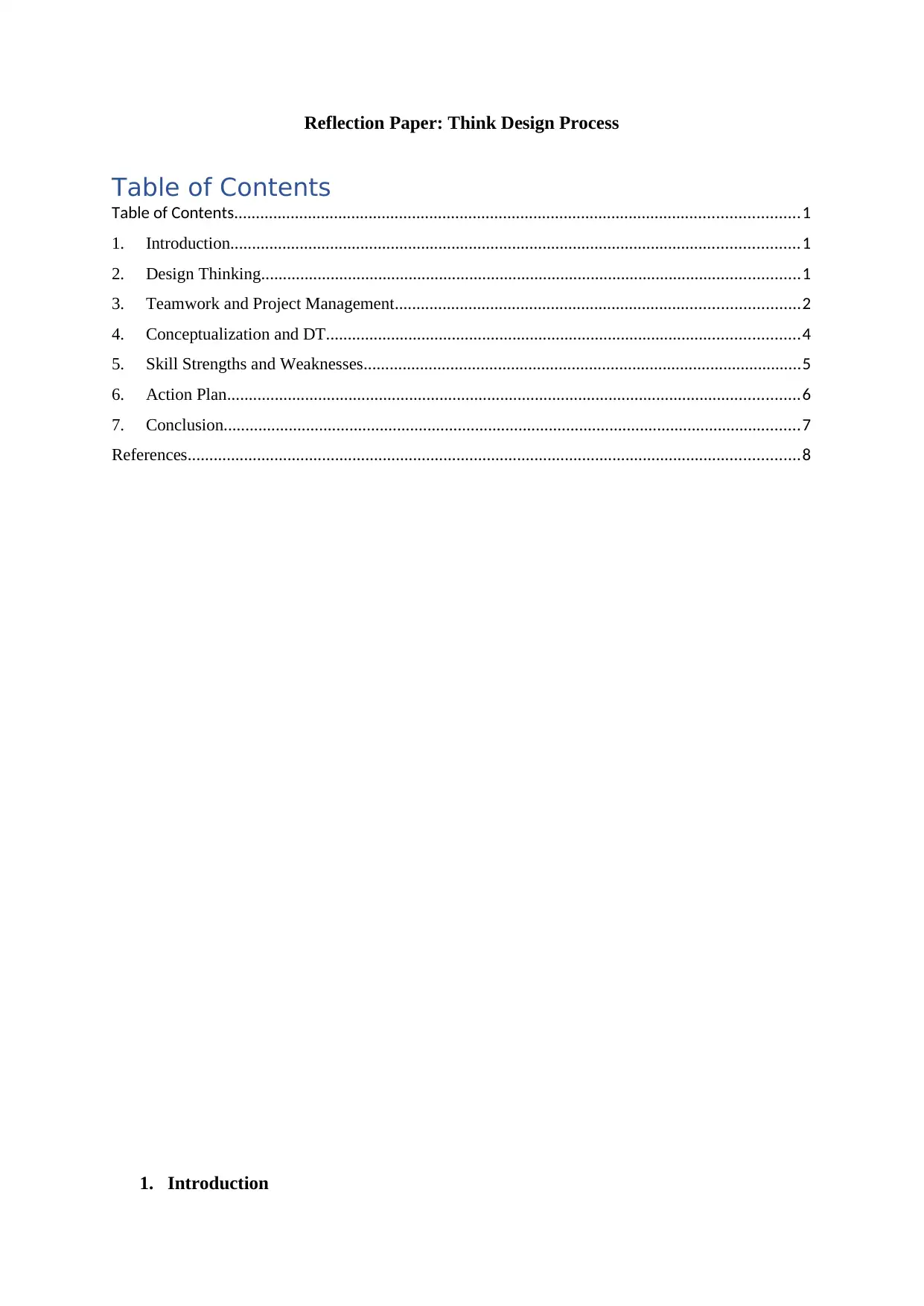
Reflection Paper: Think Design Process
Table of Contents
Table of Contents..................................................................................................................................1
1. Introduction...................................................................................................................................1
2. Design Thinking............................................................................................................................1
3. Teamwork and Project Management.............................................................................................2
4. Conceptualization and DT.............................................................................................................4
5. Skill Strengths and Weaknesses.....................................................................................................5
6. Action Plan....................................................................................................................................6
7. Conclusion.....................................................................................................................................7
References.............................................................................................................................................8
1. Introduction
Table of Contents
Table of Contents..................................................................................................................................1
1. Introduction...................................................................................................................................1
2. Design Thinking............................................................................................................................1
3. Teamwork and Project Management.............................................................................................2
4. Conceptualization and DT.............................................................................................................4
5. Skill Strengths and Weaknesses.....................................................................................................5
6. Action Plan....................................................................................................................................6
7. Conclusion.....................................................................................................................................7
References.............................................................................................................................................8
1. Introduction
Paraphrase This Document
Need a fresh take? Get an instant paraphrase of this document with our AI Paraphraser
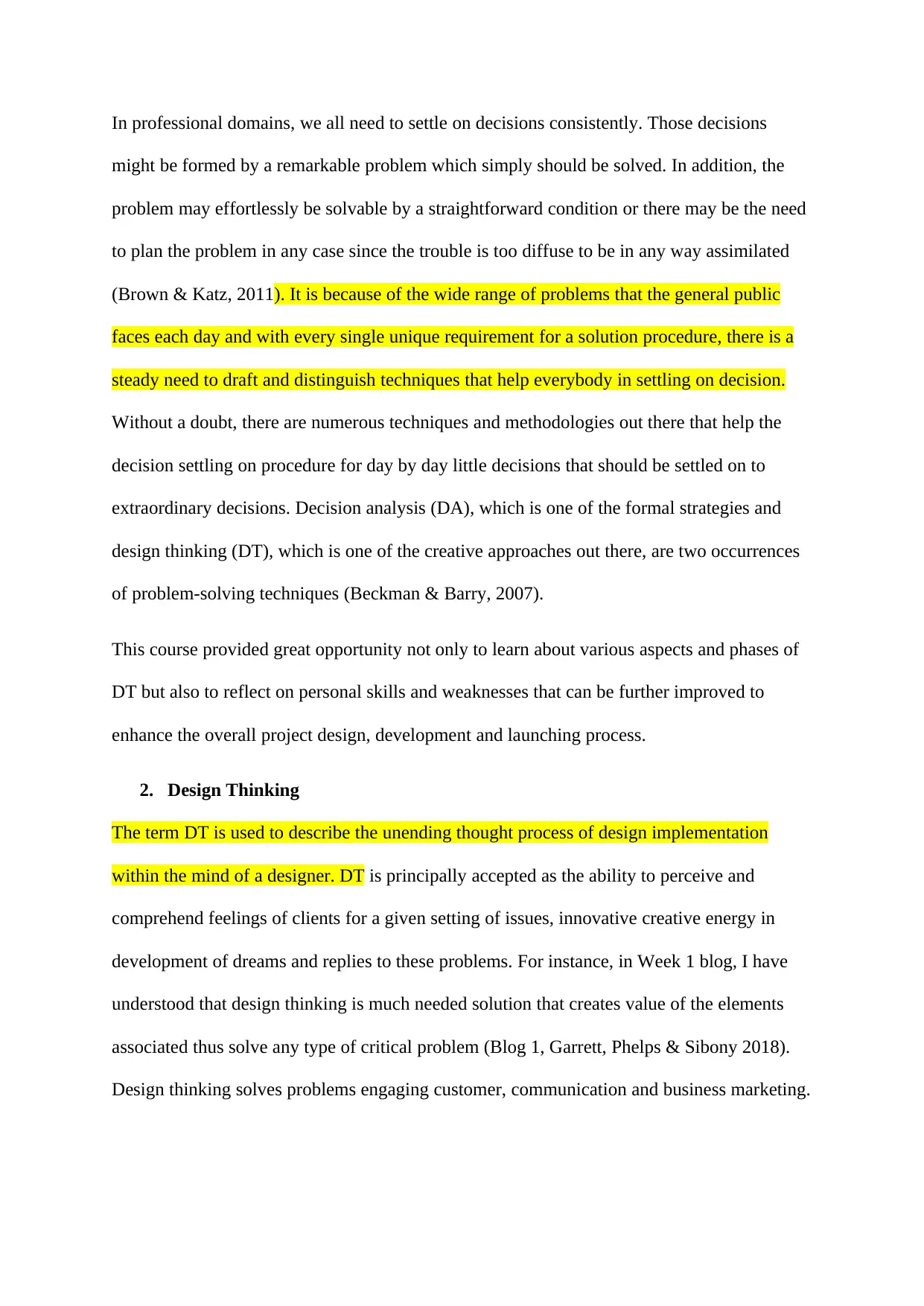
In professional domains, we all need to settle on decisions consistently. Those decisions
might be formed by a remarkable problem which simply should be solved. In addition, the
problem may effortlessly be solvable by a straightforward condition or there may be the need
to plan the problem in any case since the trouble is too diffuse to be in any way assimilated
(Brown & Katz, 2011). It is because of the wide range of problems that the general public
faces each day and with every single unique requirement for a solution procedure, there is a
steady need to draft and distinguish techniques that help everybody in settling on decision.
Without a doubt, there are numerous techniques and methodologies out there that help the
decision settling on procedure for day by day little decisions that should be settled on to
extraordinary decisions. Decision analysis (DA), which is one of the formal strategies and
design thinking (DT), which is one of the creative approaches out there, are two occurrences
of problem-solving techniques (Beckman & Barry, 2007).
This course provided great opportunity not only to learn about various aspects and phases of
DT but also to reflect on personal skills and weaknesses that can be further improved to
enhance the overall project design, development and launching process.
2. Design Thinking
The term DT is used to describe the unending thought process of design implementation
within the mind of a designer. DT is principally accepted as the ability to perceive and
comprehend feelings of clients for a given setting of issues, innovative creative energy in
development of dreams and replies to these problems. For instance, in Week 1 blog, I have
understood that design thinking is much needed solution that creates value of the elements
associated thus solve any type of critical problem (Blog 1, Garrett, Phelps & Sibony 2018).
Design thinking solves problems engaging customer, communication and business marketing.
might be formed by a remarkable problem which simply should be solved. In addition, the
problem may effortlessly be solvable by a straightforward condition or there may be the need
to plan the problem in any case since the trouble is too diffuse to be in any way assimilated
(Brown & Katz, 2011). It is because of the wide range of problems that the general public
faces each day and with every single unique requirement for a solution procedure, there is a
steady need to draft and distinguish techniques that help everybody in settling on decision.
Without a doubt, there are numerous techniques and methodologies out there that help the
decision settling on procedure for day by day little decisions that should be settled on to
extraordinary decisions. Decision analysis (DA), which is one of the formal strategies and
design thinking (DT), which is one of the creative approaches out there, are two occurrences
of problem-solving techniques (Beckman & Barry, 2007).
This course provided great opportunity not only to learn about various aspects and phases of
DT but also to reflect on personal skills and weaknesses that can be further improved to
enhance the overall project design, development and launching process.
2. Design Thinking
The term DT is used to describe the unending thought process of design implementation
within the mind of a designer. DT is principally accepted as the ability to perceive and
comprehend feelings of clients for a given setting of issues, innovative creative energy in
development of dreams and replies to these problems. For instance, in Week 1 blog, I have
understood that design thinking is much needed solution that creates value of the elements
associated thus solve any type of critical problem (Blog 1, Garrett, Phelps & Sibony 2018).
Design thinking solves problems engaging customer, communication and business marketing.
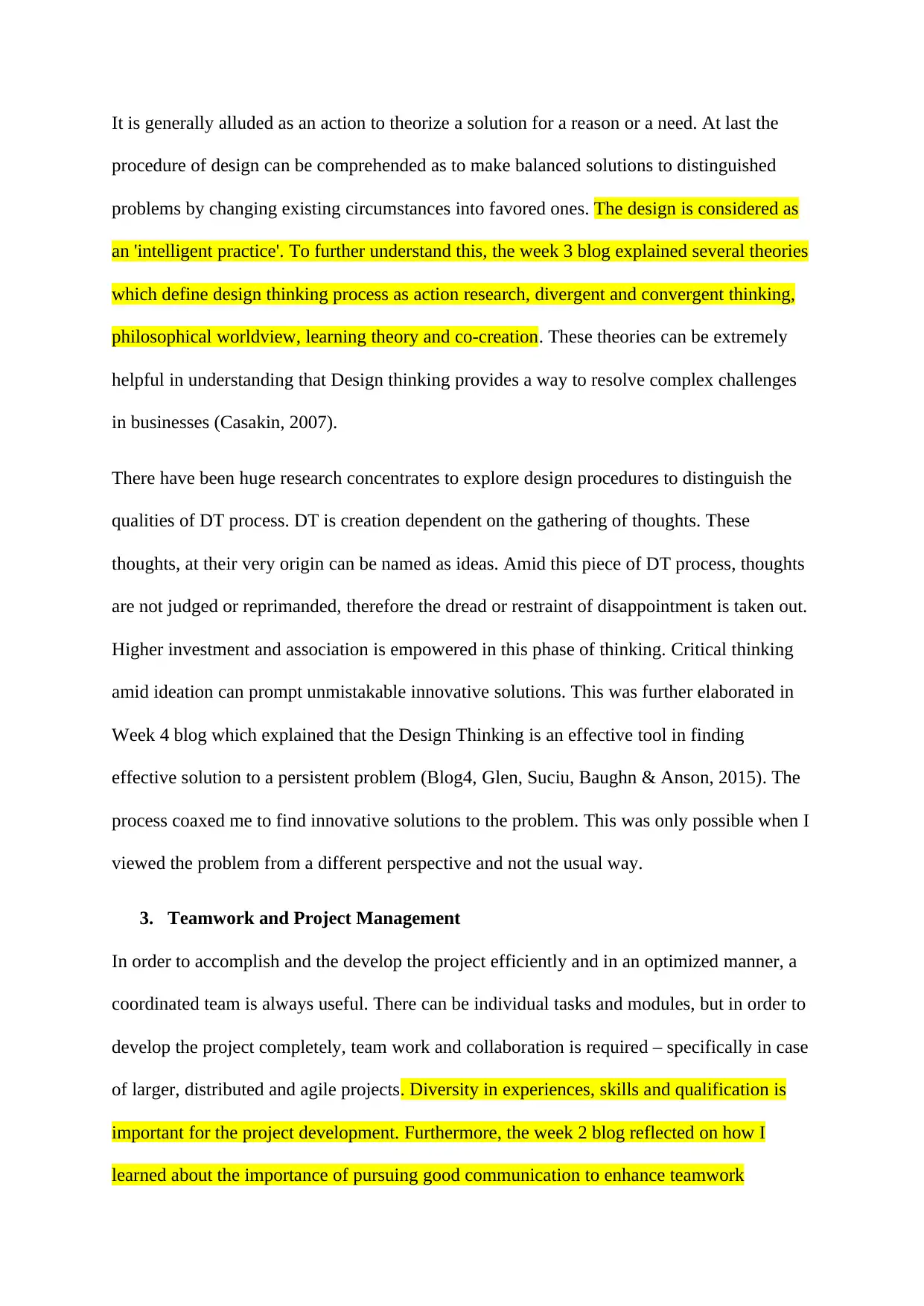
It is generally alluded as an action to theorize a solution for a reason or a need. At last the
procedure of design can be comprehended as to make balanced solutions to distinguished
problems by changing existing circumstances into favored ones. The design is considered as
an 'intelligent practice'. To further understand this, the week 3 blog explained several theories
which define design thinking process as action research, divergent and convergent thinking,
philosophical worldview, learning theory and co-creation. These theories can be extremely
helpful in understanding that Design thinking provides a way to resolve complex challenges
in businesses (Casakin, 2007).
There have been huge research concentrates to explore design procedures to distinguish the
qualities of DT process. DT is creation dependent on the gathering of thoughts. These
thoughts, at their very origin can be named as ideas. Amid this piece of DT process, thoughts
are not judged or reprimanded, therefore the dread or restraint of disappointment is taken out.
Higher investment and association is empowered in this phase of thinking. Critical thinking
amid ideation can prompt unmistakable innovative solutions. This was further elaborated in
Week 4 blog which explained that the Design Thinking is an effective tool in finding
effective solution to a persistent problem (Blog4, Glen, Suciu, Baughn & Anson, 2015). The
process coaxed me to find innovative solutions to the problem. This was only possible when I
viewed the problem from a different perspective and not the usual way.
3. Teamwork and Project Management
In order to accomplish and the develop the project efficiently and in an optimized manner, a
coordinated team is always useful. There can be individual tasks and modules, but in order to
develop the project completely, team work and collaboration is required – specifically in case
of larger, distributed and agile projects. Diversity in experiences, skills and qualification is
important for the project development. Furthermore, the week 2 blog reflected on how I
learned about the importance of pursuing good communication to enhance teamwork
procedure of design can be comprehended as to make balanced solutions to distinguished
problems by changing existing circumstances into favored ones. The design is considered as
an 'intelligent practice'. To further understand this, the week 3 blog explained several theories
which define design thinking process as action research, divergent and convergent thinking,
philosophical worldview, learning theory and co-creation. These theories can be extremely
helpful in understanding that Design thinking provides a way to resolve complex challenges
in businesses (Casakin, 2007).
There have been huge research concentrates to explore design procedures to distinguish the
qualities of DT process. DT is creation dependent on the gathering of thoughts. These
thoughts, at their very origin can be named as ideas. Amid this piece of DT process, thoughts
are not judged or reprimanded, therefore the dread or restraint of disappointment is taken out.
Higher investment and association is empowered in this phase of thinking. Critical thinking
amid ideation can prompt unmistakable innovative solutions. This was further elaborated in
Week 4 blog which explained that the Design Thinking is an effective tool in finding
effective solution to a persistent problem (Blog4, Glen, Suciu, Baughn & Anson, 2015). The
process coaxed me to find innovative solutions to the problem. This was only possible when I
viewed the problem from a different perspective and not the usual way.
3. Teamwork and Project Management
In order to accomplish and the develop the project efficiently and in an optimized manner, a
coordinated team is always useful. There can be individual tasks and modules, but in order to
develop the project completely, team work and collaboration is required – specifically in case
of larger, distributed and agile projects. Diversity in experiences, skills and qualification is
important for the project development. Furthermore, the week 2 blog reflected on how I
learned about the importance of pursuing good communication to enhance teamwork
⊘ This is a preview!⊘
Do you want full access?
Subscribe today to unlock all pages.

Trusted by 1+ million students worldwide
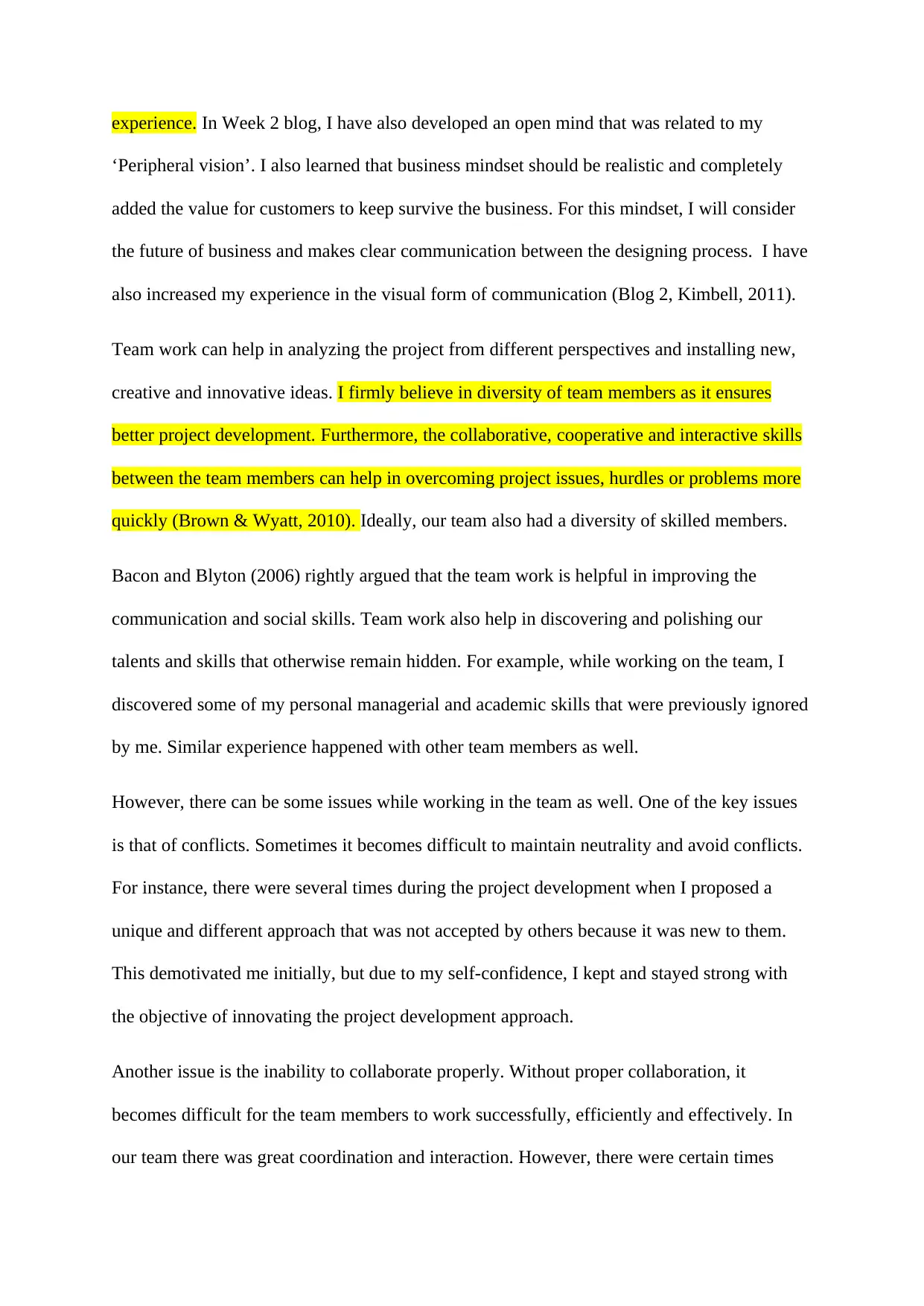
experience. In Week 2 blog, I have also developed an open mind that was related to my
‘Peripheral vision’. I also learned that business mindset should be realistic and completely
added the value for customers to keep survive the business. For this mindset, I will consider
the future of business and makes clear communication between the designing process. I have
also increased my experience in the visual form of communication (Blog 2, Kimbell, 2011).
Team work can help in analyzing the project from different perspectives and installing new,
creative and innovative ideas. I firmly believe in diversity of team members as it ensures
better project development. Furthermore, the collaborative, cooperative and interactive skills
between the team members can help in overcoming project issues, hurdles or problems more
quickly (Brown & Wyatt, 2010). Ideally, our team also had a diversity of skilled members.
Bacon and Blyton (2006) rightly argued that the team work is helpful in improving the
communication and social skills. Team work also help in discovering and polishing our
talents and skills that otherwise remain hidden. For example, while working on the team, I
discovered some of my personal managerial and academic skills that were previously ignored
by me. Similar experience happened with other team members as well.
However, there can be some issues while working in the team as well. One of the key issues
is that of conflicts. Sometimes it becomes difficult to maintain neutrality and avoid conflicts.
For instance, there were several times during the project development when I proposed a
unique and different approach that was not accepted by others because it was new to them.
This demotivated me initially, but due to my self-confidence, I kept and stayed strong with
the objective of innovating the project development approach.
Another issue is the inability to collaborate properly. Without proper collaboration, it
becomes difficult for the team members to work successfully, efficiently and effectively. In
our team there was great coordination and interaction. However, there were certain times
‘Peripheral vision’. I also learned that business mindset should be realistic and completely
added the value for customers to keep survive the business. For this mindset, I will consider
the future of business and makes clear communication between the designing process. I have
also increased my experience in the visual form of communication (Blog 2, Kimbell, 2011).
Team work can help in analyzing the project from different perspectives and installing new,
creative and innovative ideas. I firmly believe in diversity of team members as it ensures
better project development. Furthermore, the collaborative, cooperative and interactive skills
between the team members can help in overcoming project issues, hurdles or problems more
quickly (Brown & Wyatt, 2010). Ideally, our team also had a diversity of skilled members.
Bacon and Blyton (2006) rightly argued that the team work is helpful in improving the
communication and social skills. Team work also help in discovering and polishing our
talents and skills that otherwise remain hidden. For example, while working on the team, I
discovered some of my personal managerial and academic skills that were previously ignored
by me. Similar experience happened with other team members as well.
However, there can be some issues while working in the team as well. One of the key issues
is that of conflicts. Sometimes it becomes difficult to maintain neutrality and avoid conflicts.
For instance, there were several times during the project development when I proposed a
unique and different approach that was not accepted by others because it was new to them.
This demotivated me initially, but due to my self-confidence, I kept and stayed strong with
the objective of innovating the project development approach.
Another issue is the inability to collaborate properly. Without proper collaboration, it
becomes difficult for the team members to work successfully, efficiently and effectively. In
our team there was great coordination and interaction. However, there were certain times
Paraphrase This Document
Need a fresh take? Get an instant paraphrase of this document with our AI Paraphraser
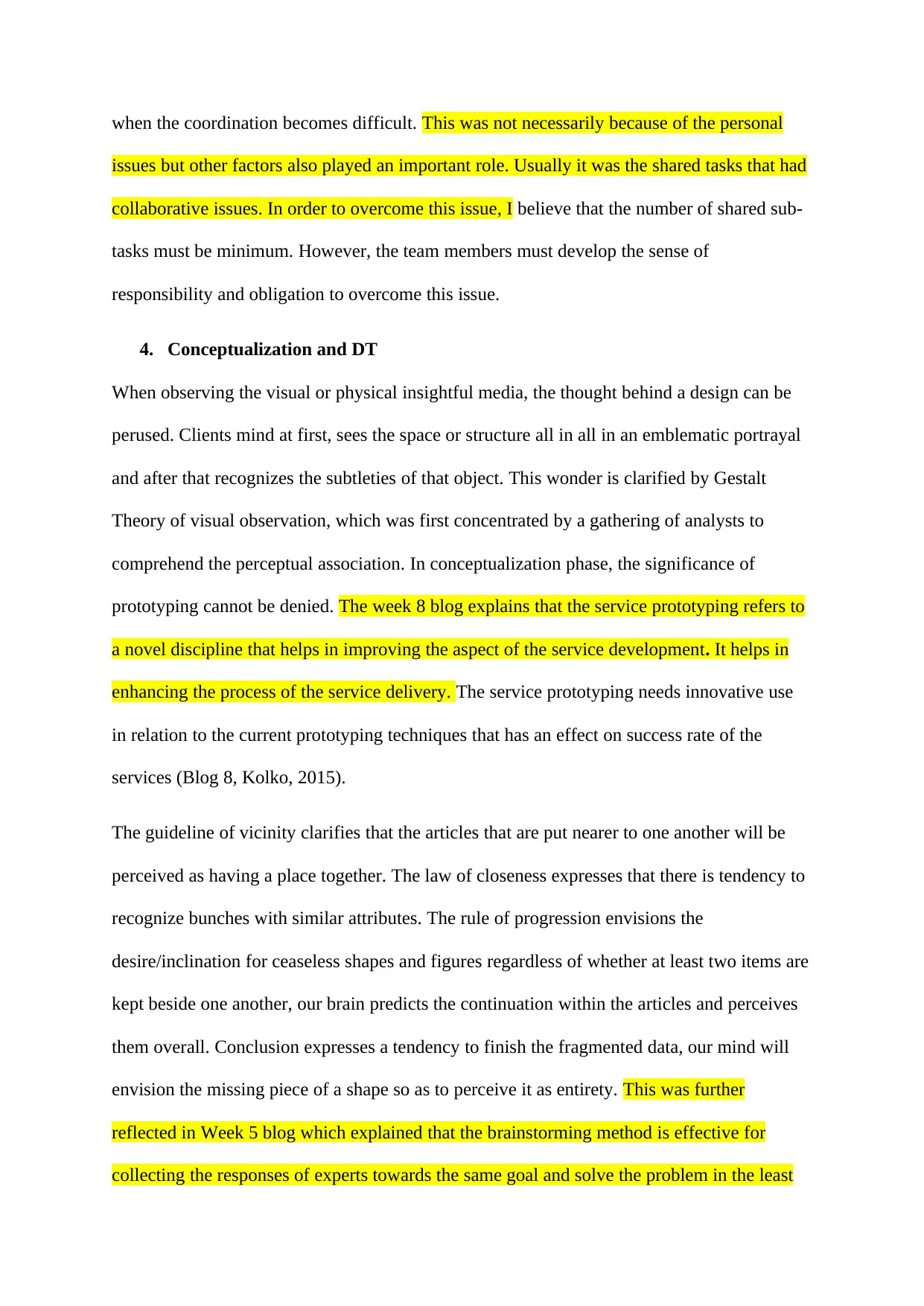
when the coordination becomes difficult. This was not necessarily because of the personal
issues but other factors also played an important role. Usually it was the shared tasks that had
collaborative issues. In order to overcome this issue, I believe that the number of shared sub-
tasks must be minimum. However, the team members must develop the sense of
responsibility and obligation to overcome this issue.
4. Conceptualization and DT
When observing the visual or physical insightful media, the thought behind a design can be
perused. Clients mind at first, sees the space or structure all in all in an emblematic portrayal
and after that recognizes the subtleties of that object. This wonder is clarified by Gestalt
Theory of visual observation, which was first concentrated by a gathering of analysts to
comprehend the perceptual association. In conceptualization phase, the significance of
prototyping cannot be denied. The week 8 blog explains that the service prototyping refers to
a novel discipline that helps in improving the aspect of the service development. It helps in
enhancing the process of the service delivery. The service prototyping needs innovative use
in relation to the current prototyping techniques that has an effect on success rate of the
services (Blog 8, Kolko, 2015).
The guideline of vicinity clarifies that the articles that are put nearer to one another will be
perceived as having a place together. The law of closeness expresses that there is tendency to
recognize bunches with similar attributes. The rule of progression envisions the
desire/inclination for ceaseless shapes and figures regardless of whether at least two items are
kept beside one another, our brain predicts the continuation within the articles and perceives
them overall. Conclusion expresses a tendency to finish the fragmented data, our mind will
envision the missing piece of a shape so as to perceive it as entirety. This was further
reflected in Week 5 blog which explained that the brainstorming method is effective for
collecting the responses of experts towards the same goal and solve the problem in the least
issues but other factors also played an important role. Usually it was the shared tasks that had
collaborative issues. In order to overcome this issue, I believe that the number of shared sub-
tasks must be minimum. However, the team members must develop the sense of
responsibility and obligation to overcome this issue.
4. Conceptualization and DT
When observing the visual or physical insightful media, the thought behind a design can be
perused. Clients mind at first, sees the space or structure all in all in an emblematic portrayal
and after that recognizes the subtleties of that object. This wonder is clarified by Gestalt
Theory of visual observation, which was first concentrated by a gathering of analysts to
comprehend the perceptual association. In conceptualization phase, the significance of
prototyping cannot be denied. The week 8 blog explains that the service prototyping refers to
a novel discipline that helps in improving the aspect of the service development. It helps in
enhancing the process of the service delivery. The service prototyping needs innovative use
in relation to the current prototyping techniques that has an effect on success rate of the
services (Blog 8, Kolko, 2015).
The guideline of vicinity clarifies that the articles that are put nearer to one another will be
perceived as having a place together. The law of closeness expresses that there is tendency to
recognize bunches with similar attributes. The rule of progression envisions the
desire/inclination for ceaseless shapes and figures regardless of whether at least two items are
kept beside one another, our brain predicts the continuation within the articles and perceives
them overall. Conclusion expresses a tendency to finish the fragmented data, our mind will
envision the missing piece of a shape so as to perceive it as entirety. This was further
reflected in Week 5 blog which explained that the brainstorming method is effective for
collecting the responses of experts towards the same goal and solve the problem in the least
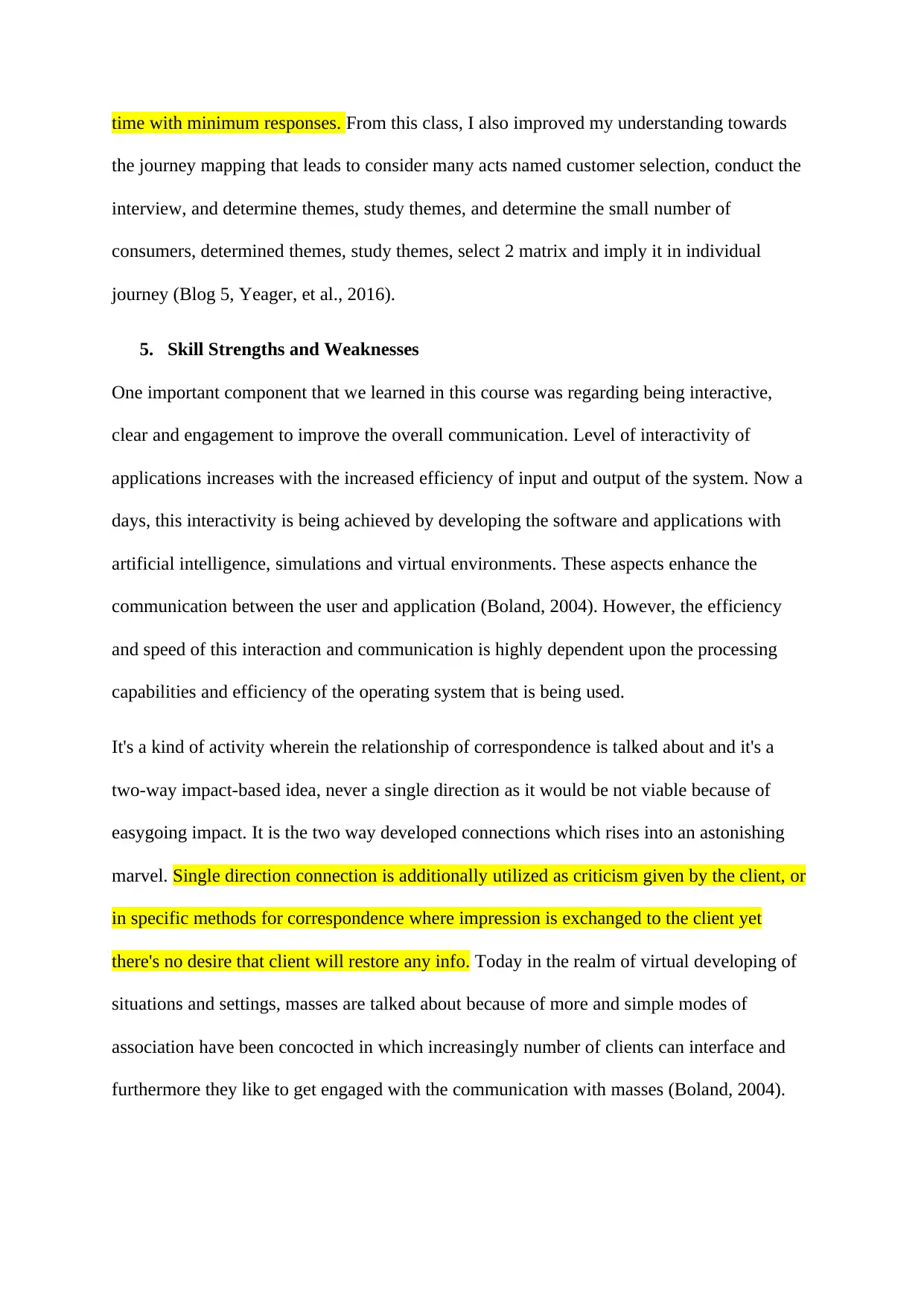
time with minimum responses. From this class, I also improved my understanding towards
the journey mapping that leads to consider many acts named customer selection, conduct the
interview, and determine themes, study themes, and determine the small number of
consumers, determined themes, study themes, select 2 matrix and imply it in individual
journey (Blog 5, Yeager, et al., 2016).
5. Skill Strengths and Weaknesses
One important component that we learned in this course was regarding being interactive,
clear and engagement to improve the overall communication. Level of interactivity of
applications increases with the increased efficiency of input and output of the system. Now a
days, this interactivity is being achieved by developing the software and applications with
artificial intelligence, simulations and virtual environments. These aspects enhance the
communication between the user and application (Boland, 2004). However, the efficiency
and speed of this interaction and communication is highly dependent upon the processing
capabilities and efficiency of the operating system that is being used.
It's a kind of activity wherein the relationship of correspondence is talked about and it's a
two-way impact-based idea, never a single direction as it would be not viable because of
easygoing impact. It is the two way developed connections which rises into an astonishing
marvel. Single direction connection is additionally utilized as criticism given by the client, or
in specific methods for correspondence where impression is exchanged to the client yet
there's no desire that client will restore any info. Today in the realm of virtual developing of
situations and settings, masses are talked about because of more and simple modes of
association have been concocted in which increasingly number of clients can interface and
furthermore they like to get engaged with the communication with masses (Boland, 2004).
the journey mapping that leads to consider many acts named customer selection, conduct the
interview, and determine themes, study themes, and determine the small number of
consumers, determined themes, study themes, select 2 matrix and imply it in individual
journey (Blog 5, Yeager, et al., 2016).
5. Skill Strengths and Weaknesses
One important component that we learned in this course was regarding being interactive,
clear and engagement to improve the overall communication. Level of interactivity of
applications increases with the increased efficiency of input and output of the system. Now a
days, this interactivity is being achieved by developing the software and applications with
artificial intelligence, simulations and virtual environments. These aspects enhance the
communication between the user and application (Boland, 2004). However, the efficiency
and speed of this interaction and communication is highly dependent upon the processing
capabilities and efficiency of the operating system that is being used.
It's a kind of activity wherein the relationship of correspondence is talked about and it's a
two-way impact-based idea, never a single direction as it would be not viable because of
easygoing impact. It is the two way developed connections which rises into an astonishing
marvel. Single direction connection is additionally utilized as criticism given by the client, or
in specific methods for correspondence where impression is exchanged to the client yet
there's no desire that client will restore any info. Today in the realm of virtual developing of
situations and settings, masses are talked about because of more and simple modes of
association have been concocted in which increasingly number of clients can interface and
furthermore they like to get engaged with the communication with masses (Boland, 2004).
⊘ This is a preview!⊘
Do you want full access?
Subscribe today to unlock all pages.

Trusted by 1+ million students worldwide
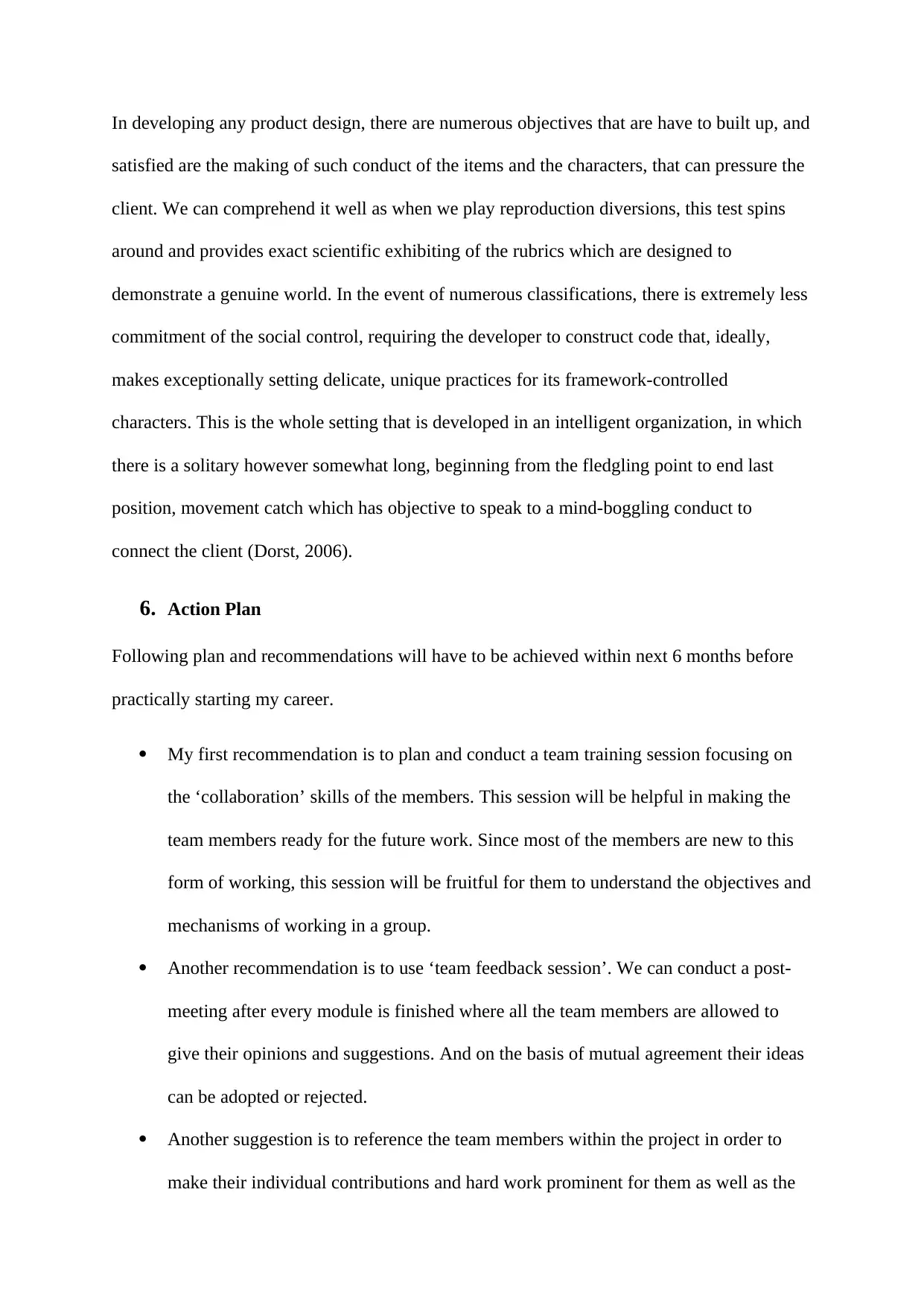
In developing any product design, there are numerous objectives that are have to built up, and
satisfied are the making of such conduct of the items and the characters, that can pressure the
client. We can comprehend it well as when we play reproduction diversions, this test spins
around and provides exact scientific exhibiting of the rubrics which are designed to
demonstrate a genuine world. In the event of numerous classifications, there is extremely less
commitment of the social control, requiring the developer to construct code that, ideally,
makes exceptionally setting delicate, unique practices for its framework-controlled
characters. This is the whole setting that is developed in an intelligent organization, in which
there is a solitary however somewhat long, beginning from the fledgling point to end last
position, movement catch which has objective to speak to a mind-boggling conduct to
connect the client (Dorst, 2006).
6. Action Plan
Following plan and recommendations will have to be achieved within next 6 months before
practically starting my career.
My first recommendation is to plan and conduct a team training session focusing on
the ‘collaboration’ skills of the members. This session will be helpful in making the
team members ready for the future work. Since most of the members are new to this
form of working, this session will be fruitful for them to understand the objectives and
mechanisms of working in a group.
Another recommendation is to use ‘team feedback session’. We can conduct a post-
meeting after every module is finished where all the team members are allowed to
give their opinions and suggestions. And on the basis of mutual agreement their ideas
can be adopted or rejected.
Another suggestion is to reference the team members within the project in order to
make their individual contributions and hard work prominent for them as well as the
satisfied are the making of such conduct of the items and the characters, that can pressure the
client. We can comprehend it well as when we play reproduction diversions, this test spins
around and provides exact scientific exhibiting of the rubrics which are designed to
demonstrate a genuine world. In the event of numerous classifications, there is extremely less
commitment of the social control, requiring the developer to construct code that, ideally,
makes exceptionally setting delicate, unique practices for its framework-controlled
characters. This is the whole setting that is developed in an intelligent organization, in which
there is a solitary however somewhat long, beginning from the fledgling point to end last
position, movement catch which has objective to speak to a mind-boggling conduct to
connect the client (Dorst, 2006).
6. Action Plan
Following plan and recommendations will have to be achieved within next 6 months before
practically starting my career.
My first recommendation is to plan and conduct a team training session focusing on
the ‘collaboration’ skills of the members. This session will be helpful in making the
team members ready for the future work. Since most of the members are new to this
form of working, this session will be fruitful for them to understand the objectives and
mechanisms of working in a group.
Another recommendation is to use ‘team feedback session’. We can conduct a post-
meeting after every module is finished where all the team members are allowed to
give their opinions and suggestions. And on the basis of mutual agreement their ideas
can be adopted or rejected.
Another suggestion is to reference the team members within the project in order to
make their individual contributions and hard work prominent for them as well as the
Paraphrase This Document
Need a fresh take? Get an instant paraphrase of this document with our AI Paraphraser
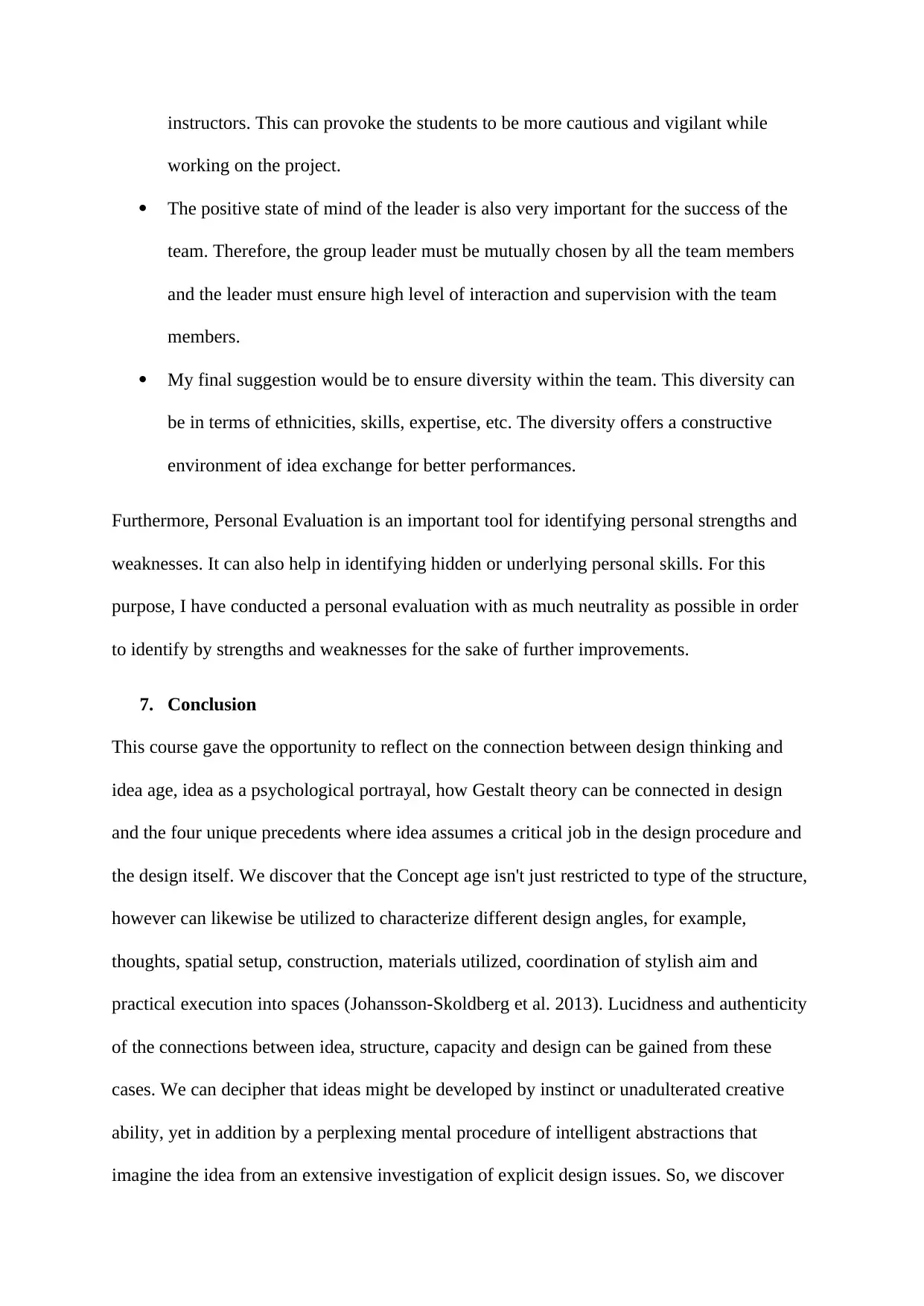
instructors. This can provoke the students to be more cautious and vigilant while
working on the project.
The positive state of mind of the leader is also very important for the success of the
team. Therefore, the group leader must be mutually chosen by all the team members
and the leader must ensure high level of interaction and supervision with the team
members.
My final suggestion would be to ensure diversity within the team. This diversity can
be in terms of ethnicities, skills, expertise, etc. The diversity offers a constructive
environment of idea exchange for better performances.
Furthermore, Personal Evaluation is an important tool for identifying personal strengths and
weaknesses. It can also help in identifying hidden or underlying personal skills. For this
purpose, I have conducted a personal evaluation with as much neutrality as possible in order
to identify by strengths and weaknesses for the sake of further improvements.
7. Conclusion
This course gave the opportunity to reflect on the connection between design thinking and
idea age, idea as a psychological portrayal, how Gestalt theory can be connected in design
and the four unique precedents where idea assumes a critical job in the design procedure and
the design itself. We discover that the Concept age isn't just restricted to type of the structure,
however can likewise be utilized to characterize different design angles, for example,
thoughts, spatial setup, construction, materials utilized, coordination of stylish aim and
practical execution into spaces (Johansson-Skoldberg et al. 2013). Lucidness and authenticity
of the connections between idea, structure, capacity and design can be gained from these
cases. We can decipher that ideas might be developed by instinct or unadulterated creative
ability, yet in addition by a perplexing mental procedure of intelligent abstractions that
imagine the idea from an extensive investigation of explicit design issues. So, we discover
working on the project.
The positive state of mind of the leader is also very important for the success of the
team. Therefore, the group leader must be mutually chosen by all the team members
and the leader must ensure high level of interaction and supervision with the team
members.
My final suggestion would be to ensure diversity within the team. This diversity can
be in terms of ethnicities, skills, expertise, etc. The diversity offers a constructive
environment of idea exchange for better performances.
Furthermore, Personal Evaluation is an important tool for identifying personal strengths and
weaknesses. It can also help in identifying hidden or underlying personal skills. For this
purpose, I have conducted a personal evaluation with as much neutrality as possible in order
to identify by strengths and weaknesses for the sake of further improvements.
7. Conclusion
This course gave the opportunity to reflect on the connection between design thinking and
idea age, idea as a psychological portrayal, how Gestalt theory can be connected in design
and the four unique precedents where idea assumes a critical job in the design procedure and
the design itself. We discover that the Concept age isn't just restricted to type of the structure,
however can likewise be utilized to characterize different design angles, for example,
thoughts, spatial setup, construction, materials utilized, coordination of stylish aim and
practical execution into spaces (Johansson-Skoldberg et al. 2013). Lucidness and authenticity
of the connections between idea, structure, capacity and design can be gained from these
cases. We can decipher that ideas might be developed by instinct or unadulterated creative
ability, yet in addition by a perplexing mental procedure of intelligent abstractions that
imagine the idea from an extensive investigation of explicit design issues. So, we discover
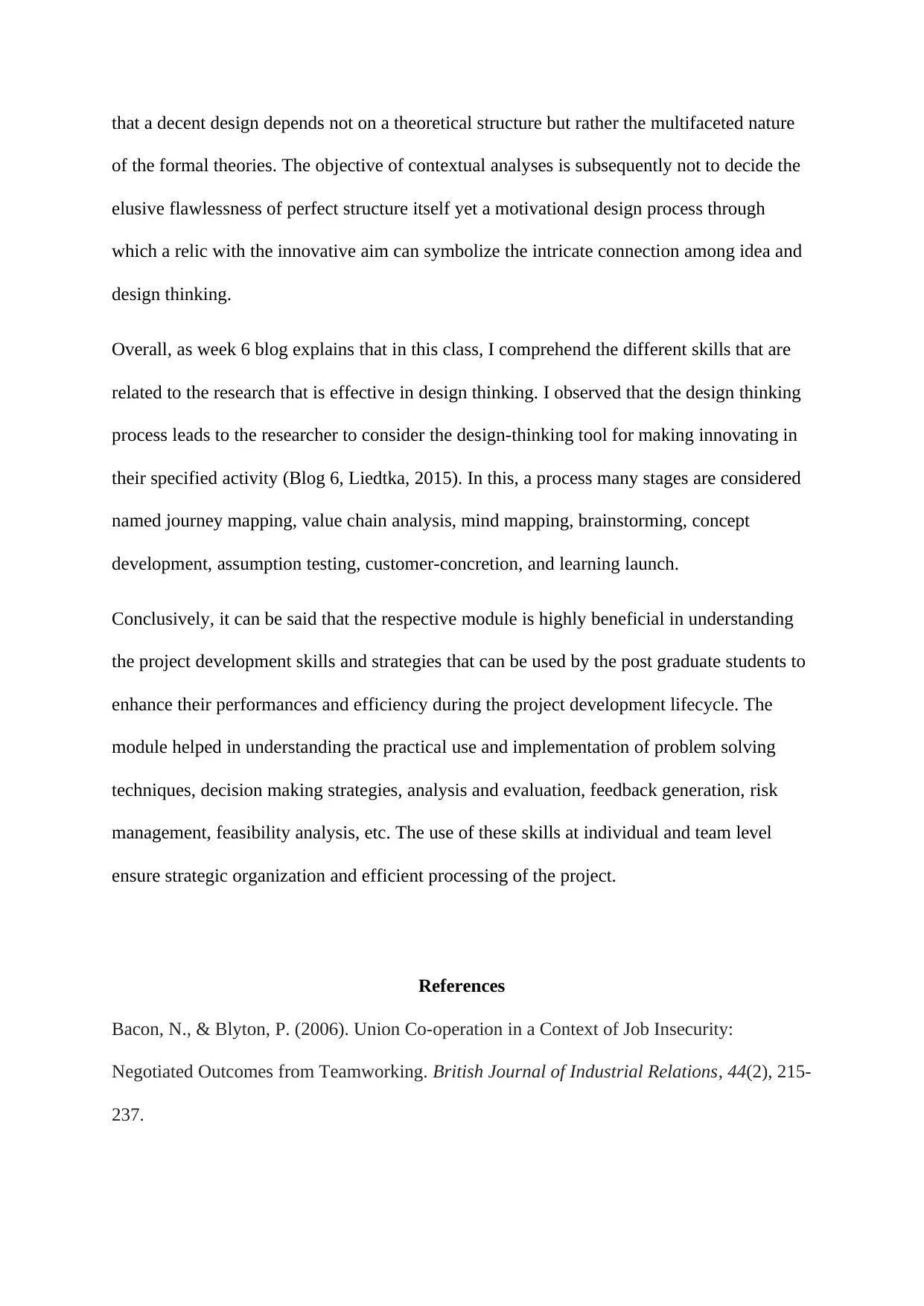
that a decent design depends not on a theoretical structure but rather the multifaceted nature
of the formal theories. The objective of contextual analyses is subsequently not to decide the
elusive flawlessness of perfect structure itself yet a motivational design process through
which a relic with the innovative aim can symbolize the intricate connection among idea and
design thinking.
Overall, as week 6 blog explains that in this class, I comprehend the different skills that are
related to the research that is effective in design thinking. I observed that the design thinking
process leads to the researcher to consider the design-thinking tool for making innovating in
their specified activity (Blog 6, Liedtka, 2015). In this, a process many stages are considered
named journey mapping, value chain analysis, mind mapping, brainstorming, concept
development, assumption testing, customer-concretion, and learning launch.
Conclusively, it can be said that the respective module is highly beneficial in understanding
the project development skills and strategies that can be used by the post graduate students to
enhance their performances and efficiency during the project development lifecycle. The
module helped in understanding the practical use and implementation of problem solving
techniques, decision making strategies, analysis and evaluation, feedback generation, risk
management, feasibility analysis, etc. The use of these skills at individual and team level
ensure strategic organization and efficient processing of the project.
References
Bacon, N., & Blyton, P. (2006). Union Co‐operation in a Context of Job Insecurity:
Negotiated Outcomes from Teamworking. British Journal of Industrial Relations, 44(2), 215-
237.
of the formal theories. The objective of contextual analyses is subsequently not to decide the
elusive flawlessness of perfect structure itself yet a motivational design process through
which a relic with the innovative aim can symbolize the intricate connection among idea and
design thinking.
Overall, as week 6 blog explains that in this class, I comprehend the different skills that are
related to the research that is effective in design thinking. I observed that the design thinking
process leads to the researcher to consider the design-thinking tool for making innovating in
their specified activity (Blog 6, Liedtka, 2015). In this, a process many stages are considered
named journey mapping, value chain analysis, mind mapping, brainstorming, concept
development, assumption testing, customer-concretion, and learning launch.
Conclusively, it can be said that the respective module is highly beneficial in understanding
the project development skills and strategies that can be used by the post graduate students to
enhance their performances and efficiency during the project development lifecycle. The
module helped in understanding the practical use and implementation of problem solving
techniques, decision making strategies, analysis and evaluation, feedback generation, risk
management, feasibility analysis, etc. The use of these skills at individual and team level
ensure strategic organization and efficient processing of the project.
References
Bacon, N., & Blyton, P. (2006). Union Co‐operation in a Context of Job Insecurity:
Negotiated Outcomes from Teamworking. British Journal of Industrial Relations, 44(2), 215-
237.
⊘ This is a preview!⊘
Do you want full access?
Subscribe today to unlock all pages.

Trusted by 1+ million students worldwide
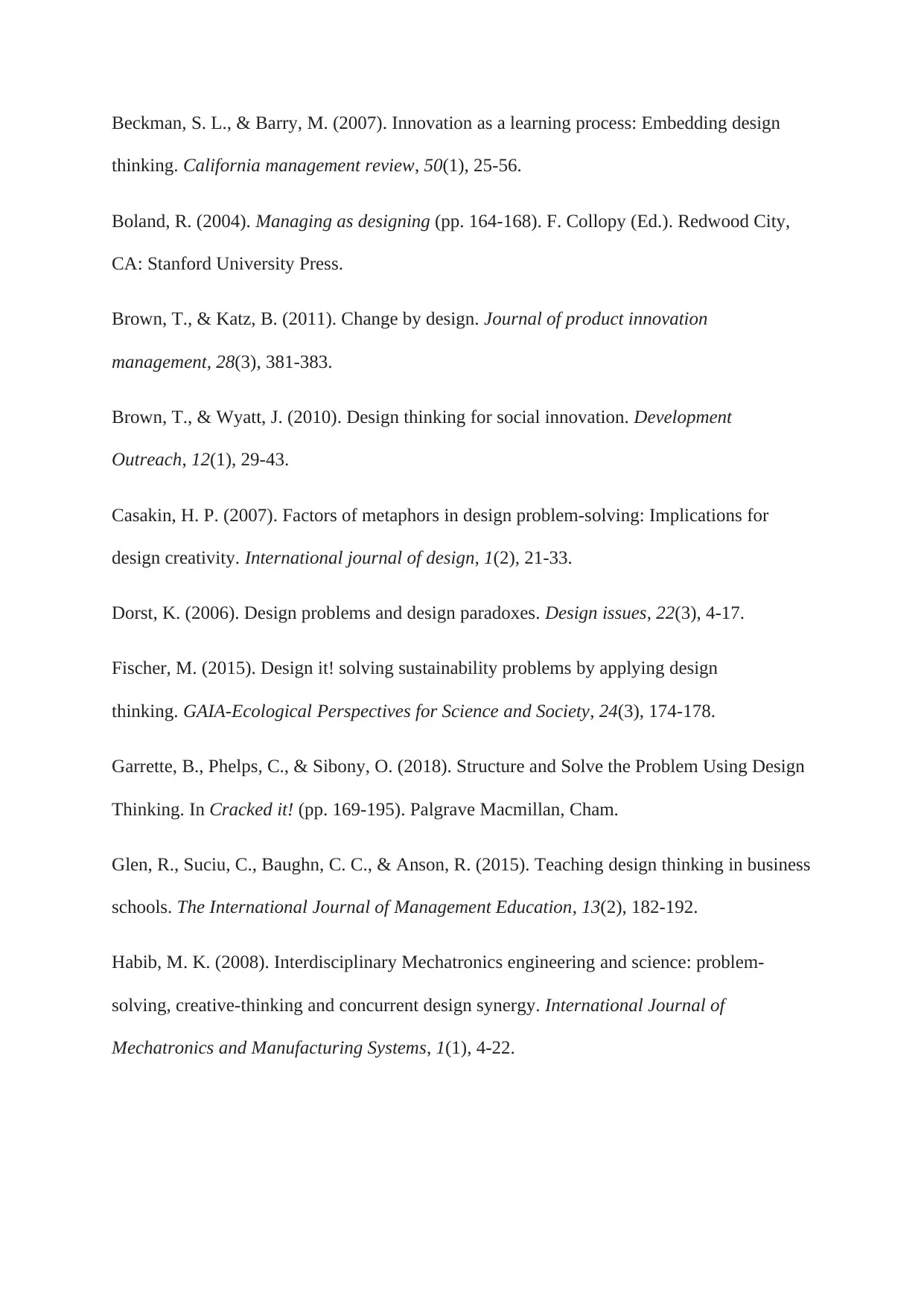
Beckman, S. L., & Barry, M. (2007). Innovation as a learning process: Embedding design
thinking. California management review, 50(1), 25-56.
Boland, R. (2004). Managing as designing (pp. 164-168). F. Collopy (Ed.). Redwood City,
CA: Stanford University Press.
Brown, T., & Katz, B. (2011). Change by design. Journal of product innovation
management, 28(3), 381-383.
Brown, T., & Wyatt, J. (2010). Design thinking for social innovation. Development
Outreach, 12(1), 29-43.
Casakin, H. P. (2007). Factors of metaphors in design problem-solving: Implications for
design creativity. International journal of design, 1(2), 21-33.
Dorst, K. (2006). Design problems and design paradoxes. Design issues, 22(3), 4-17.
Fischer, M. (2015). Design it! solving sustainability problems by applying design
thinking. GAIA-Ecological Perspectives for Science and Society, 24(3), 174-178.
Garrette, B., Phelps, C., & Sibony, O. (2018). Structure and Solve the Problem Using Design
Thinking. In Cracked it! (pp. 169-195). Palgrave Macmillan, Cham.
Glen, R., Suciu, C., Baughn, C. C., & Anson, R. (2015). Teaching design thinking in business
schools. The International Journal of Management Education, 13(2), 182-192.
Habib, M. K. (2008). Interdisciplinary Mechatronics engineering and science: problem-
solving, creative-thinking and concurrent design synergy. International Journal of
Mechatronics and Manufacturing Systems, 1(1), 4-22.
thinking. California management review, 50(1), 25-56.
Boland, R. (2004). Managing as designing (pp. 164-168). F. Collopy (Ed.). Redwood City,
CA: Stanford University Press.
Brown, T., & Katz, B. (2011). Change by design. Journal of product innovation
management, 28(3), 381-383.
Brown, T., & Wyatt, J. (2010). Design thinking for social innovation. Development
Outreach, 12(1), 29-43.
Casakin, H. P. (2007). Factors of metaphors in design problem-solving: Implications for
design creativity. International journal of design, 1(2), 21-33.
Dorst, K. (2006). Design problems and design paradoxes. Design issues, 22(3), 4-17.
Fischer, M. (2015). Design it! solving sustainability problems by applying design
thinking. GAIA-Ecological Perspectives for Science and Society, 24(3), 174-178.
Garrette, B., Phelps, C., & Sibony, O. (2018). Structure and Solve the Problem Using Design
Thinking. In Cracked it! (pp. 169-195). Palgrave Macmillan, Cham.
Glen, R., Suciu, C., Baughn, C. C., & Anson, R. (2015). Teaching design thinking in business
schools. The International Journal of Management Education, 13(2), 182-192.
Habib, M. K. (2008). Interdisciplinary Mechatronics engineering and science: problem-
solving, creative-thinking and concurrent design synergy. International Journal of
Mechatronics and Manufacturing Systems, 1(1), 4-22.
Paraphrase This Document
Need a fresh take? Get an instant paraphrase of this document with our AI Paraphraser
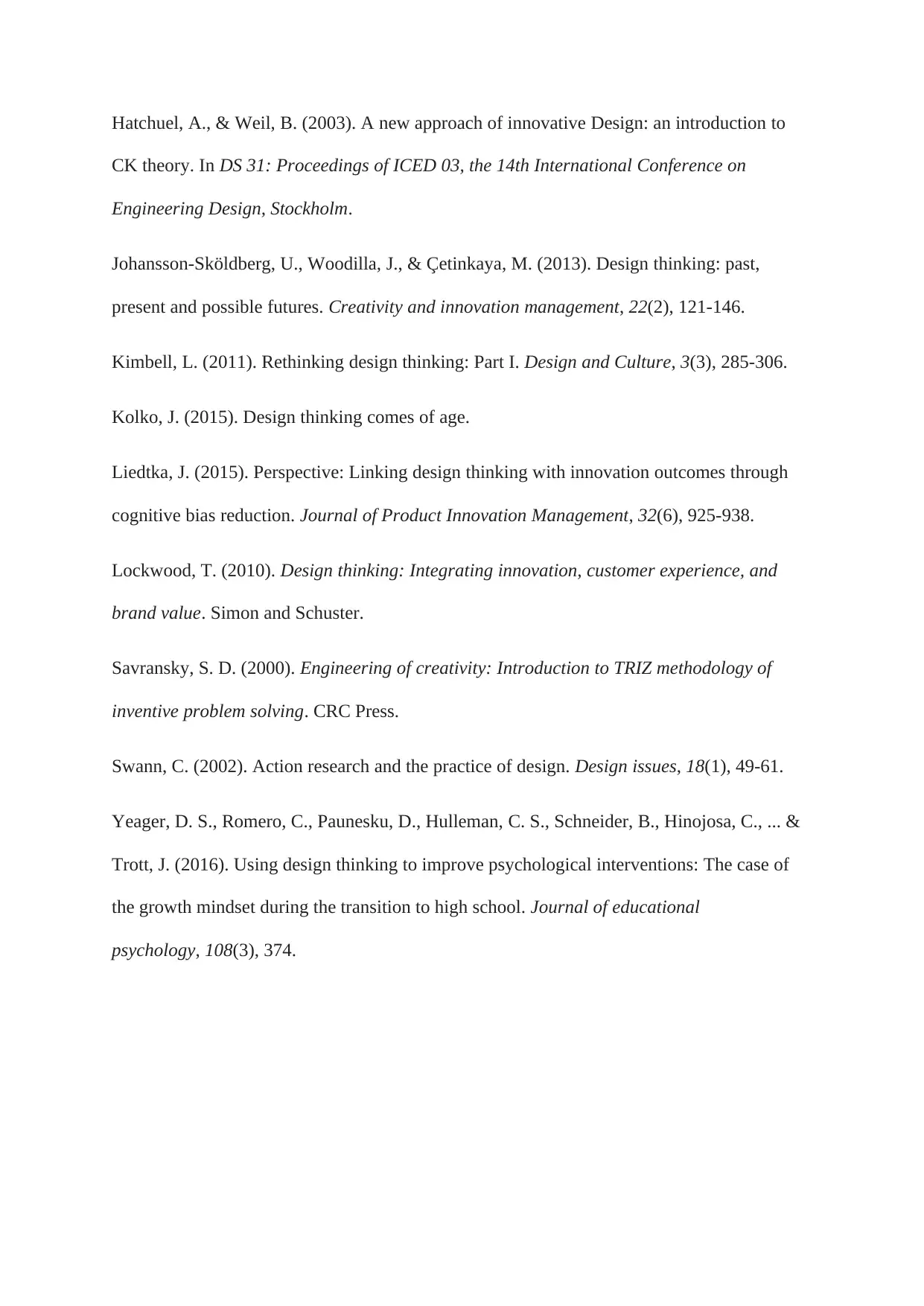
Hatchuel, A., & Weil, B. (2003). A new approach of innovative Design: an introduction to
CK theory. In DS 31: Proceedings of ICED 03, the 14th International Conference on
Engineering Design, Stockholm.
Johansson‐Sköldberg, U., Woodilla, J., & Çetinkaya, M. (2013). Design thinking: past,
present and possible futures. Creativity and innovation management, 22(2), 121-146.
Kimbell, L. (2011). Rethinking design thinking: Part I. Design and Culture, 3(3), 285-306.
Kolko, J. (2015). Design thinking comes of age.
Liedtka, J. (2015). Perspective: Linking design thinking with innovation outcomes through
cognitive bias reduction. Journal of Product Innovation Management, 32(6), 925-938.
Lockwood, T. (2010). Design thinking: Integrating innovation, customer experience, and
brand value. Simon and Schuster.
Savransky, S. D. (2000). Engineering of creativity: Introduction to TRIZ methodology of
inventive problem solving. CRC Press.
Swann, C. (2002). Action research and the practice of design. Design issues, 18(1), 49-61.
Yeager, D. S., Romero, C., Paunesku, D., Hulleman, C. S., Schneider, B., Hinojosa, C., ... &
Trott, J. (2016). Using design thinking to improve psychological interventions: The case of
the growth mindset during the transition to high school. Journal of educational
psychology, 108(3), 374.
CK theory. In DS 31: Proceedings of ICED 03, the 14th International Conference on
Engineering Design, Stockholm.
Johansson‐Sköldberg, U., Woodilla, J., & Çetinkaya, M. (2013). Design thinking: past,
present and possible futures. Creativity and innovation management, 22(2), 121-146.
Kimbell, L. (2011). Rethinking design thinking: Part I. Design and Culture, 3(3), 285-306.
Kolko, J. (2015). Design thinking comes of age.
Liedtka, J. (2015). Perspective: Linking design thinking with innovation outcomes through
cognitive bias reduction. Journal of Product Innovation Management, 32(6), 925-938.
Lockwood, T. (2010). Design thinking: Integrating innovation, customer experience, and
brand value. Simon and Schuster.
Savransky, S. D. (2000). Engineering of creativity: Introduction to TRIZ methodology of
inventive problem solving. CRC Press.
Swann, C. (2002). Action research and the practice of design. Design issues, 18(1), 49-61.
Yeager, D. S., Romero, C., Paunesku, D., Hulleman, C. S., Schneider, B., Hinojosa, C., ... &
Trott, J. (2016). Using design thinking to improve psychological interventions: The case of
the growth mindset during the transition to high school. Journal of educational
psychology, 108(3), 374.
1 out of 11
Related Documents
Your All-in-One AI-Powered Toolkit for Academic Success.
+13062052269
info@desklib.com
Available 24*7 on WhatsApp / Email
![[object Object]](/_next/static/media/star-bottom.7253800d.svg)
Unlock your academic potential
Copyright © 2020–2025 A2Z Services. All Rights Reserved. Developed and managed by ZUCOL.





